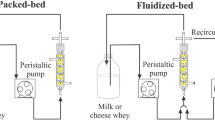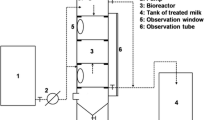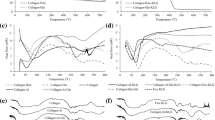Abstract
The research field for applications of lactose hydrolysis has been investigated for several decades. Lactose intolerance, improvement for technical processing of solutions containing lactose, and utilization of lactose in whey are the main topics for development of biotechnological processes. We report here the optimization of a hollow-fiber membrane reactor process for enzymatic lactose hydrolysis. Lactase was circulated abluminally during luminal flow of skim milk. The main problem, the growth of microorganisms in the enzyme solution, was minimized by sterile filtration, ultraviolet irradiation, and temperature adjustment. Based on previous experiments at 23±2°C, further characterization was carried out at 8±2°C, 15±2°C (β-galactosidase), and 58±2°C (thermostable β-glycosidase) varying enzyme activity and flow rates. For a cost-effective process, the parameters 15±2°C, 240 U/mL of β-galactosidase, an enzyme solution flow rate of 25 L/h, and a skim milk flow rate of about 9 L/h should be used in order to achieve an aimed productivity of 360 g/(L·h) and to run at conditions for the highest process long-term stability.
Similar content being viewed by others
References
Ruttloff, H. (1994), Lactase. Industrielle Enzyme, 2nd ed., Behr’s Verlag, Hamburg, Germany, pp. 766–777.
Zadow, J. G. (1992), in Lactose Hydrolysis in Whey and Lactose Processing, (Zadow, J. G., ed.), Elsevier Science, Amsterdam, The Netherlands, pp. 2–21.
Pivarnik, L. F., Senecal, A. G., and Rand, A. G. (1995), in Advances in Food and Nutrition: Research, vol. 3, (Kinsella, J. E. and Taylor, D. L., eds.), Academic, New York, pp. 1–101.
Mahoney, R. R. (1985), in Developments in Dairy Chemistry, vol. 3, (Fox, P. F., ed.), Elsevier Applied Science, Amsterdam, The Netherlands, pp. 69–108.
Gekas, V. and Lopez-Leiva, M. (1985), Process Biochem. 20, 2–12.
Richmond, M. L., Gray, J. I., and Stine, C. M. (1981), J. Dairy Sci. 64, 1759–1771.
Reimerdes, E. h. (1985), Abschlußbericht BM f. Forschung und Technologie, Reference number 038491, Follow-up report PTB 0382628, Bonn, Germany.
Czermak, P., Eberhard, G., König, A., Tretzel, J., Reimerdes, E. H., and Bauer, W. (1988), in DECHEMA Biotechnology Conferences 2, (Behrens, D., ed.), VCH Verlagsgesellschaft, Weinheim, pp. 133–145.
Czermak, P. and Bauer, W. (1990), in DECHEMA Biotechnology Conferences 4 (Behrens, D., ed.), VCH Verlagsgesellschaft, Weinheim, pp. 763–766.
Czermak, P., Bahr, D., and Bauer, W. (1990), Chem. Ing. Tech. 62, 678–679.
Czermak, P. (1992), Bioengineering 8(1), 47–52.
Novalin, S., Neuhaus, W., and Kulbe, K. D. (2005), J. Biotechnol. 119(2), 212–218.
Voorhorst, W. G., Eggen, R. I., Luesink, E. J., and de Vos, D. M. (1995), J. Bacteriol. 177, 7105–7111.
Splechtna, B., Petzelbauer, I., Kuhn, B., Kulbe, K. D., and Nidetzky, B. (2002), Appl. Biochem. Biotechnol. 98–100, 473–488.
Petzelbauer, I., Nidetzky, B., Haltrich, D., and Kulbe, K. D. (1999), Biotechnol. Bioeng. 64(3), 322–332.
Author information
Authors and Affiliations
Corresponding author
Additional information
A correction to this article is available at http://dx.doi.org/10.1385/ABAB:135:2:179
Rights and permissions
About this article
Cite this article
Neuhaus, W., Novalin, S., Klimacek, M. et al. Optimization of an innovative hollow-fiber process to produce lactose-reduced skim milk. Appl Biochem Biotechnol 134, 1–14 (2006). https://doi.org/10.1385/ABAB:134:1:1
Received:
Revised:
Accepted:
Published:
Issue Date:
DOI: https://doi.org/10.1385/ABAB:134:1:1




